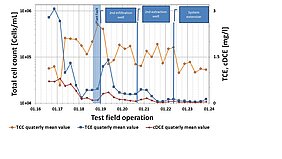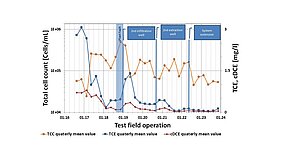A new biologically productive degradation pathway of trichloroethene is promising for the elimination of pollutants in groundwater. To determine the site-specific degradation potential and to monitor the processes taking place in the underground, a simulation model was created for the first time that was previously not available.
Contaminations of volatile chlorinated hydrocarbons continue to threaten groundwater as the most important drinking water resource worldwide and prevent land use and reuse. Tetrachloroethene (perchloroethene, PCE) and trichloroethene (TCE) are widely used solvents and are the common groundwater contaminants. Recently, a new aerobic degradation pathway of TCE has been described, which offers benefits as compared to conventional processes, such as no requirement of auxiliary substrates and no competitive reactions for oxygen consumption. This aerobic productive degradation of TCE represents a promising possibility for the elimination of pollutants in groundwater. There is a need among site owners, consultants and technical authorities to determine the site-specific degradation potential and to monitor the biodegradation processes. Together with a medium-sized enterprise, an innovative reactive transport model was developed that describes the aerobic LCKW degradation based on the monod degradation kinetics of the microorganisms. For the first time, a module based on data from extensive studies of the growth kinetics of TCE-degrading microorganisms was developed. The laboratory data at the TZW showed that the initial TCE concentration and the amount of TCE degraders are important input parameters for the degradation kinetics. Flow cytometry proved to be a successful method for tracking the growth of bacteria. The methods were validated at a total of eight different sites.
Publications
Gaza S.: Aerob-produktiver Abbau von Chlorethenen: Nachweis eines neuen Abbauweges für Trichlorethen. Veröffentlichungen aus dem Technologiezentrum Wasser, ISSN 1434-5765, TZW-Band 66 (2015)
Gaza S., Schmidt K.R., Weigold P., Heidinger M., Tiehm A.: Aerobic metabolic trichloroethene biodegradation under field-relevant conditions. Water Research 151: 343-348 (2019) DOI 10.1016/j.watres.2018.12.022
Hertle, S; Behrendt, A; Willmann, A; Stelmaszyk, L; Ho, J; Müller, M; Tiehm, A: Vorkommen, Stimulation und Nachweis des aeroben metabolischen TCE-Abbaus. In: Symposium Strategien zur Boden- und Grundwassersanierung. DECHEMA, Frankfurt, 27. – 28. November 2023, Tagungsband (2023)
Müller A., Schäfer W., Schumacher K., Hoffmann U., Nordmann T., Puster H., Tiehm A: Sequentiell anaerob-aerober LCKW-Abbau an der ehemaligen chemischen Reinigung Hemesath. In: 24. Symposium Strategien zur Sanierung von Boden & Grundwasser, DECHEMA, Frankfurt, 28./29. Nov. 2022, Tagungsband: 52–57 (2022)
Schmidt K., Gaza S., Voropaev A., Ertl S., Tiehm A.: Aerobic biodegradation of trichloroethene without auxiliary substrates. Water Research 59: 112-118 (2014) DOI 10.1016/j.watres.2014.04.008
Schmidt K.R., Augenstein T., Heidinger M., Ertl S., Tiehm A.: Aerobic biodegradation of cis-1,2-dichloroethene as sole carbon source: Stable carbon isotope fractionation and growth characteristics. Chemosphere 78: 527-532 (2010) DOI.org/10.1016/j.chemosphere.2009.11.033
Schmidt K.R., Tiehm A.: Natural Attenuation am Chlorethen-Standort Frankenthal: Bedeutung des sequentiell anaerob-aeroben Bio-Abbaus. Altlastenspektrum 05.11: 212-219 (2011)
Willmann, A; Tiehm, A.: Aerobic co-metabolic cis-Dichloroethene degradation with Trichloroethene as primary substrate and effects of concentration ratios. Chemosphere 350, 141000 (2024) DOI: 10.1016/j.chemosphere.2023.141000.
Willmann, A.; Trautmann, A.-L.; Kushmaro, A.; Tiehm, A.: Intrinsic and bioaugmented aerobic trichloroethene degradation at seven sites. Heliyon 9, 2: e13485 (2023) DOI: 10.1016/j.heliyon.2023.e13485
The volumes of the TZW publications can be ordered here.

![[Translate to English:] Prüfstelle-Produktprüfung_Teststand Test centre and product testing](/fileadmin/_processed_/0/9/csm_TZW-Karlsruhe_Pruefung_Geraete-Teststand_377188946c.jpg)
























![[Translate to English:] [Translate to English:]](/fileadmin/_processed_/6/d/csm_Gesamtzellzall__Durchflusszytometrie__c92447da1c.jpg)




